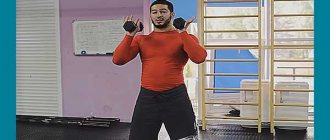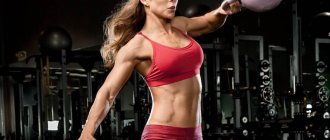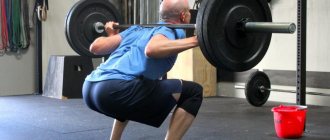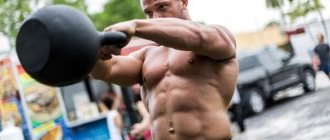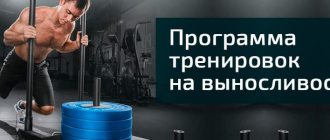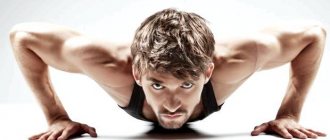Hello, friends. Why do we need kettlebell exercises for fighters? What actions are most effective for an MMA fighter? What activities are best for a boxer? And are heavy shells necessarily required?
Fighters of different disciplines (boxing, wrestling, MMA, etc.) must improve physically. There are a lot of methods and tools for this. Working with a kettlebell is considered quite effective. The parameters of the projectile and training with it are selected based on the fighter’s goals.
Work of fighters with weights: a set of exercises for wrestlers and boxers
Hello, friends. Why do we need kettlebell exercises for fighters? What actions are most effective for an MMA fighter? What activities are best for a boxer? And are heavy shells necessarily required?
Fighters of different disciplines (boxing, wrestling, MMA, etc.) must improve physically. There are a lot of methods and tools for this. Working with a kettlebell is considered quite effective. The parameters of the projectile and training with it are selected based on the fighter’s goals.
The importance of kettlebell training
Thanks to this activity, many muscle groups develop. What matters here is the specificity of this projectile - the wandering center of gravity. Its position is influenced by the type of grip.
Also, due to such activities, there is a powerful development of hands and strength endurance.
For training, you need to choose the right equipment. It is not necessary to immediately work with a product weighing at least 16 kg. It is important to act gradually here. And after the exercises, do arm throws.
Often the initial work is built with 10 and 12 kg shells. Gradually the mass increases.
General complexes for fighters
There are various variations of activities with this sports equipment. But the most popular set of exercises with a kettlebell for fighters is the following option. It consists of the following points:
- Standing press. The weight is located on the shoulder. Palm facing forward. Squat down slightly, push up the apparatus, while straightening your legs. In the first classes, the load is 10 repetitions. Then it develops to 15.
- Tossing. Feet are placed wider than shoulder width. The projectile is on the surface between the legs. You need to throw it up with one hand and put it down. When falling, the weight rotates around its axis. At this moment she needs to be caught. In an optimal situation, it is caught at the navel line. 2-3 repetitions are enough here.
- Deadlift. The position of the legs is twice the width of the shoulders. The position of the projectile is as in paragraph 2. Grasp it with both hands and straighten up to your full height. Immediately lift the product above your head. The initial norm is 5 repetitions. Then their number reaches 10.
- Dips. A projectile weighing no more than 10 kg is used. He is tied to his feet. You should do push-ups 6-10 times. You can gradually increase the weight of the product and the number of repetitions.
These are popular kettlebell exercises for wrestlers and boxers. Many domestic wrestlers and representatives of other disciplines paid serious attention to them. One of the most striking examples is Ivan Poddubny.
Water polo
If you have ever watched water polo, its presence in the selection will not surprise you. There is so much fury in this sport that even the most brutal boxer would be jealous. There are only three things prohibited in water polo:
- drown or hold a player;
- attack a player not in possession of the ball;
- sink the ball.
Athletes bite each other, gouge out eyes, push each other, hit each other hard in the face (by accident, of course). Water polo players are strong, resilient and fierce. At the same time, they are always on the alert: they can attack from any side, including under water. Doesn't remind you of anything? This is the same street fight, only in the water and under the watchful eye of thousands of fans.
MMA fighter and kettlebell
Representatives of this discipline train with this apparatus according to a strict program. In general, the lesson consists of 5 approaches. Each lasts about 20 minutes.
Each kettlebell exercise presented below for MMA fighters takes approximately 4 minutes. Pause between approaches – 1 minute.
And their program is like this:
- Combo. Lunges are performed with jerks.
- Twisting.
- Lift carried out through the side. At the same time there is a bench press.
- Position – half bridge. An alternate press is performed.
- Carrying out swings of the “in-out” type.
Each exercise has 5 approaches. Each side is given half a minute.
Boxer working with a kettlebell
In boxing there are no exercises for a specific muscle group. Every exercise uses all the muscles. The basics of the program are rapid jerking movements.
The following complex of work with kettlebells is most suitable for a boxer:
- Push from the shoulder upward. The movement starts from the foot. First of all, the leg is twisted onto the toe. Then an impulse is given and a push is made. Load – 10 times per hand.
- Squats. The position of the hands is kept perpendicular to the floor surface. To optimize balance, weights can be placed under your heels. The norm is 10 times.
- A jerk from the floor in an upward direction. The projectile rises from the floor with a jerking movement. At the top peak point it is held slightly in front of the face. The main thing here is not to slouch. The load is similar to step 1.
- Swing in a sitting position. The movements are performed by the widest muscles of the back. The shoulders here are auxiliary components. The position of the back in relation to the surface is perpendicular. She leans back minimally. The load is identical to point 2
- Ups. Get down on one knee and immediately on the other. Then lie down. The ascent is performed in reverse order. The weight is always in the hand and perpendicular to the surface. Each hand needs to do 3 lifts.
- Mahi. Push from your hips. Don't bend your back. Avoid pendulum movements. Load – 20 repetitions.
- Tilts. The projectile is behind the back. She is always level. There should be no arching in the lower back. Lifting is done from the muscles of the legs and buttocks. The number of repetitions is identical to step 7
- Swing to the chest. When bending the body, the back is kept straight and not rounded. There is also no need to scroll the brushes. The projectile unfolds by inertia. Similar load to steps 7 and 8.
Before the complex, a warm-up is required. It consists of a 15-minute run and five minutes of joint exercises.
The break between points is half a minute.
After class – light jogging for 10 minutes.
Only one such training is carried out per week. Other classes focus on weight-free activities.
Examples of exercises with kettlebells
1 set of exercises with weights:
- 50 swings with a kettlebell (swing exercise with a kettlebell)
- 20 squats with a kettlebell at the chest
Complete this set of kettlebell exercises for as many repetitions as possible in 20 minutes.
2 set of exercises with weights for advanced athletes:
- 60 cleans + kettlebell push (30 reps with each arm)
- 200 jumping jacks with kettlebells in hands
- 40 cleans + kettlebell push (20 each arm)
- 150 jumping jacks with kettlebell in hands
- 20 cleans + kettlebell push (10 each arm)
- 100 jumping jacks with a kettlebell in your hands
- 10 cleans + kettlebell push (5 each arm)
- 50 jumping jacks with a kettlebell in your hands
Do three repetitions of the entire set with 5 minutes of rest between sets.
Exercises for fighters with kettlebells
One of the effective means of strength training for hand-to-hand fighters is kettlebell lifting exercises, since they are accessible and have a comprehensive effect on the musculoskeletal system, training a colossal grip.
At the same time, as an analysis of scientific and educational literature has shown [1-9, etc.], today, questions regarding the specifics of the methodology for using kettlebell lifting exercises in preparing hand-to-hand fighters remain insufficiently addressed. This creates certain difficulties when programming and organizing training sessions in hand-to-hand combat based on the use of exercises with weights.
In this regard, the purpose of our research is to identify the features of the methodology for using exercises with kettlebells, taking into account the commonality of kettlebell lifting techniques and hand-to-hand combat in the training of hand-to-hand fighters.
Material and research methods. To achieve the goal, the following research methods were used: analysis of scientific and methodological literature, generalization of the experience of one’s own training and competitive activities, conversation with hand-to-hand fighters, with weight lifters and their coaches, pedagogical monitoring (diagnosis of the level of development of hand-to-hand fighting qualities), mathematical statistics.
Research results and discussion. When training hand-to-hand fighters, the problem of combining strength training with the formation of fighting qualities is relevant. An important condition for strength training is the commonality of the technique of motor actions in strength exercises and exercises that develop the fighting qualities of an athlete.
The nature and conditions of muscle efforts developed during hand-to-hand combat are very diverse. To perform specific striking actions, a high level of development of “explosive” force is required. The effectiveness of protection is also largely related to the ability to exert shock-absorbing force when performing, for example, blocks, landings on a support, etc. And the high reactive ability of the motor system, associated with an instant switch from the inferior mode to the overcoming mode of muscle work, is necessary when performing blocks with a subsequent attack or a series of various jumping strikes. Performing quick actions associated with movements and changes in position depends on the manifestation of fast dynamic force. In direct contact with an opponent in close combat, the effectiveness of power combat, physical “suppression” of the enemy will depend on athletic preparedness, on the level of development of power qualities. Active hand-to-hand combat, even for 1–2 minutes, requires a high level of development of special power endurance. Therefore, strength endurance is also one of the most important strength qualities in hand-to-hand combat.
Kettlebell in martial arts
1. Significant increase in the force required for a knockout blow.
2. Functional endurance training. Your opponent won't be able to breathe, and you won't even be out of breath.
3. A shifted center of gravity will help develop the entire body symmetrically. Thanks to training with kettlebells, you will immediately identify your weak points.
4. Fast recovery. To reap the full benefits of kettlebell training, you don't need to train to failure. You will recover very quickly and kettlebell training will not interfere with your regular workouts.
The complex described below consists of 8 exercises; these exercises are suitable both for general body training and for athletes who engage in martial arts. When using these exercises, endurance, strength are trained very well, and the tendon is strengthened.
So let's get started?
1. Warm up the wrist.
We take two weights, arms down, and turn the hands left and right, in each direction 10 times.
2 Shoulder warm-up (swings).
The arms are lowered and extended downwards, we swing our arms simultaneously in a horizontal position, with our left hand we swing to the right side, with our right hand we swing to the left. It is very important to set the trajectory so that when swinging simultaneously you do not hit the kettlebell with the kettlebell.
3 Warm up the whole arm (swings).
We make simultaneous swings with our arms only in a vertical position. In the highest position, we squeeze our arm at the elbow, as if giving additional load to the biceps.
4. Circular movements of weights (rolling).
We take the weight with both hands, by the side handles, so that our fists are vertical. We hold the weight with outstretched arms opposite our chest. We make circular movements towards and away from ourselves clockwise. The main thing is that the legs are in a stance position (one leg is slightly in front of the other, the other is behind); when “rolling” the legs, pelvis and body should also work together with the arms.
Then we do the same circular movements, only counterclockwise.
It is important that the kettlebell is aligned with your chest at all times.
Note: This exercise is suitable for wrestlers because... It really strengthens your hands.
5. Kettlebell throws.
The essence of the exercise is to strengthen the tendon, pump up all the muscles of the arms and the latissimus.
And so, we take the weight with both hands, by the side handles, stand in a fighting stance, one leg in front, the other in the back, and, as it were, hit a direct blow with the body, with the pelvis as it should be. We hold the weight opposite the chin.
If you are right-handed, then the right hand in the process of impact (throwing out) will be slightly higher than the left, that is, the right is at the top, and the left is at the bottom, as if supporting the weight. The position of the weight should be closer to a horizontal position.
Then we change the stance and position of the hands, and perform the exercise.
6. Jerk
The snatch is a basic kettlebell exercise, in this case the whole body works.
The main thing is correct that you need to tear with your legs and lats, not with your arms, because... your hands will be the first to get tired. Also make sure that your back is straight.
7. Push.
Another classic exercise that gives maximum load to the muscles of the back, legs, and arms. When using the push exercise, we train good endurance.
Here, as in the snatch, you need to put maximum effort on your legs and not on your arms.
8. Jerk without squatting.
This exercise is performed almost exactly the same as the classic “push”, only without a squat, and we put maximum effort not on the legs, but on the arms, it turns out that you are raising and lowering the weights.
After these exercises, it is recommended to do push-ups from the floor and hang on the crossbar, if available.
I do exercise 1-2-3 in one approach, 10 times.
I do all subsequent exercises in 3 approaches, each approach 10 times. Using one-pound weights. Of course, you can adjust the number of approaches and the number of times each to suit yourself and your capabilities.
Deryabin Peter
A set of exercises with weights for fighters
Greetings to all readers of the sportivs blog. Alexander Bely is with you. In this article we will talk about various exercises with kettlebells. Let's look at a training complex for MMA fighters, and also watch an informative video.
Almost all combat athletes regularly train with weights. An important part of training is kettlebell exercises for fighters. With the help of this type of load, strength endurance develops well.
A training complex with weights is very convenient, since you do not need to use various equipment; you simply need weights of 8, 16 or 32 kg.
What are the positive benefits of training:
- The work and flexibility of the ligaments improves.
- Grip strength develops.
- The development of the hand is a very important factor when training strikes.
- Kettlebells help you learn to adjust to your center of gravity.
- Kettlebell training helps speed up your metabolism and also increases testosterone levels.
A comprehensive workout will help you work out even the smallest muscle fibers thoroughly and in detail. A positive quality is ease of use - unlike a number of exercise machines and barbells that are found in the gym, you only need one piece of equipment - a kettlebell. This workout perfectly works more than one muscle at a time - the basic load is distributed over several types of muscles.
Is it safe to assume that kettlebell exercises are all you need?
The kettlebell is a fantastic training tool, but it's nothing more than a tool. Sellers of sports equipment offer many types of exercise equipment for various purposes. There are no varieties of kettlebells. It's not part of any piece of equipment that will give you everything you need, but kettlebell training will give you the opportunity to target many areas.
In general, the most compelling reason to buy sports weights: cast iron or collapsible - whichever you prefer - is that they take up very little space .
You can store a kettlebell in the trunk of your car, and when you realize that you don't have time for your next workout at the gym, take it out and do a set of exercises with a kettlebell.
How to approach training correctly
Now I will describe to you several recommendations and tips that will help you achieve good results, as well as protect yourself from unwanted injuries, because everyone wants to be healthy and strong, and not sick, right?
Warm up thoroughly before starting your workout. Warm up your ligaments and joints, prepare the ligamentous-articular apparatus for work.
A good warm-up allows you to:
- Stretch and tone muscle fibers.
- Cardiovascular activity increases, as a result of which active blood flow to the muscles begins.
- Prevents various injuries.
- Accelerates the metabolic rate.
- Improves functioning and tones the nervous system.
- Gives a positive attitude towards training.
You need to carefully monitor the technique of performing each exercise. It is better to do less, but correctly, than more, but poorly.
In kettlebell lifting, I do not recommend doing approaches to the limit, because this apparatus is not a barbell or a dumbbell; here, during fatigue, the technique begins to deteriorate and ultimately this can contribute to a loss of balance or control, which will lead to an undesirable result.
Before each approach, carefully think over the working weight, do not under any circumstances overestimate yourself, because working with weights is a more traumatic workout than with a barbell or dumbbells.
Weight-lifting
A punch that lands in your opponent's face is a ballistic motion.
Kettlebell exercises are precisely aimed at generating force in such movements. In terms of effectiveness, they are similar only to weightlifting training. The difference is that the latter specialize in bilateral exercises (with two hands), while the movements of kettlebell lifters are unilateral (with one hand). In kettlebell lifting there are 3 factors that turn an athlete into a street fighting professional :
- Training with kettlebells gives exactly that sharp starting arm strength that is so necessary for striking. In addition, when holding the weight in the upper position, the elbow ligaments, which work to throw the arm, are perfectly pumped. That's why weightlifters hit quickly and sharply.
- There are exercises that, when repeated many times, perfectly train dynamic hip extension. These are high pulls, swings and snatches, in which the athlete throws the weight upward. In a fight, hip extension is responsible for generating punching force.
- By holding a kettlebell on the chest or at arm's length, the athlete works on wrist position and joint stiffness. When fighting, they make sure that the entire force of the blow reaches the target.
Some weightlifters even say that they are afraid of street fights because they can easily kill an opponent with one blow. Not surprising: their blows are very strong, especially if performed directly from the shoulder and with all the weight. The main thing is to hit the target the first time, training will do the rest. You won’t envy your opponent at this moment.
Training program
Now we will look at the basic exercises with a kettlebell, which MMA fighters very often use in their training.
- Romanian kettlebell deadlift. You will be able to warm up in an excellent way, you will use the muscles of your arms (biceps, triceps), as well as your back. A great prototype for the deadlift, be sure to keep your back straight as you perform it.
- Kettlebell snatch with one hand. I recommend performing it in the first phase of training, since it involves lifting a projectile above your head, and for a tired body, holding a heavy weight above your head is strongly not recommended. When performing, technique plays a special role; you should not lean your supporting hand on your leg, the projectile does not fall completely to the ground. If you feel that your hand is tired, you need to change it.
- Kettlebell swings. With straight arms, the kettlebell is brought out between the legs and raised to eye level. This exercise uses the deltoid muscles.
- Cleans and kettlebell presses. The projectile is lifted onto the chest with one hand, then squeezed above oneself. If you feel the weight is too much for you, take less. It would be optimal to do 10 times on each hand.
- Renegade Pull. You stand in a prone position, only on weights. You should do push-ups from the floor (projectile), then lean back a little and raise one arm. Coordination and grip develop perfectly. The muscles of the chest and arms are involved.
- High pull deadlift. With your feet slightly wider than shoulder-width apart and the bar between your legs, perform a classic deadlift, then lift the barbell up to your chin. Do it 10 times. An excellent exercise for the back muscles and deltoids. Develops grip strength by lifting weights to chin level.
- Kettlebell Bench Press. Lie on the floor with your arms straight with the weights in front of you. Raise them in front of you, 10 times on each hand. The pectoral muscles are well worked out.
- Concentrated curls with kettlebells. While working, the biceps are worked out perfectly. Can be done both on a bench and in a standing position. It is necessary to keep your back straight, while leaning forward slightly, and rest your other hand on your leg. Perform 10 times on each hand. The exercise can be used as a finishing exercise; it can be done to failure.
I would like to draw your attention to the fact that in addition to developing strength indicators, stretching is very important for fighters, thanks to which they perform sharp and fast kicks. For many, stretching the legs is a significant, almost unattainable problem. Therefore, in order to significantly improve your fighting technique and finally do the splits, I recommend studying the step-by-step video course “How to do the splits .
We, dear readers, have reviewed the basic exercises with kettlebells for MMA fighters, which are used to strengthen ligaments and joints, muscles, and grip. Be sure to watch the informative video in which you will find interesting nuances about exercising with weights.
Stay with me and keep reading the blog, which I am sure will bring you positive and interesting information on developing your body. If you liked the article, you can recommend it to your friends by sharing it. Bye.
What are the benefits of exercises with kettlebells?
Coordination of movements develops
Kettlebells are very effective in training judo wrestlers because they do not focus on one muscle group (like exercise machines), but force different muscle groups to work in a coordinated manner, i.e. contribute to the coordination development of the athlete.
Develops functional strength
Have you ever fought someone who could barely lift 30kg on the bench press, but during the fight you realized that he was as strong as an ox? This is functional strength. Simply put, this is the ability to mobilize all of your internal power reserves when necessary.
Stabilizing muscles are involved
The kettlebell uses stabilizer muscles because it has uneven weight. You need to apply extra force when performing a kettlebell push, kettlebell snatch, or lift.
Pulse takes off like a rocket
If you do swings with a kettlebell (“swing”) for 5-10 minutes, it will seem to you that you have run a full cross-country race. Kettlebell exercises such as swings, cleans and jerks are a test of strength endurance.
Strengthens the buttocks
Proper technique for performing the kettlebell swing strengthens your glutes, an area of the body that is often overlooked by athletes and trainers. In addition, the “swing” also serves to strengthen the lower body and hips.
Moves the muscles of the entire body
Each kettlebell exercise uses more than half the muscles in your body. Whether you're doing swings or overhead presses, you'll always be working more than one muscle group. This is great for judo wrestlers as they use multiple muscle groups during a match.
Develops grip strength
Holding the handle of a kettlebell for 5 minutes will give you a buzzing pain in your forearm.
Directed training of the weaker side is possible
Do you notice that one of your hands is stronger than the other? Just focus more on your weak side kettlebell exercises.
Fast fat burning
Whether you're just lifting weights or doing clean and jerks, remember that intense exercise will help burn a lot of calories. Therefore, kettlebell exercises are great for people who want to lose weight and tone up.
So, kettlebells are just a tool in your arsenal. This means that weights are not the only way to gain strength and improve physical fitness. There are many different methods and techniques for kettlebell training that can definitely help you improve your fitness and strength, but it is not a one-size-fits-all tool that can be used to meet the individual goals of each athlete or coach.
Complex "Gladiator"
One of our best instructors, while training at RKC, used this particular complex to demonstrate the usefulness of kettlebells in functional training and strength development. Gabriele DiAngelo, an Italian taekwondo athlete, also used this program, but to develop not only strength, but also mental toughness, which is very important in the fight against fatigue.
Of course I asked why he gave the complex a name. And I heard this answer: “That’s because all “ass-kicking” complexes should have names.” This complex is aimed at training the “posterior chain” necessary to withstand hard blows, be able to securely grab your opponent, develop grip strength and overall physical strength. The complex with weights is also suitable for developing mental toughness; it helps to cope with fatigue.
Hockey
In terms of aggressiveness and the number of power moves on the field, hockey can compete with rugby. This is another contact sport that is impossible to imagine without a fight. Some athletes even agree on sparring in advance, thereby killing two birds with one stone: they add entertainment to the match and distract the enemy’s attention from the goal.
Moreover, in hockey, forceful techniques in the fight for the puck are officially allowed (within reasonable limits, of course). Therefore, before matches, hockey players not only train on the ice, but also practice their punches to perfection on a punching bag. Judges approve fights where athletes of equal strength compete. But often even the most intelligent planned fight escalates into an uncontrollable brawl.
Six week scheme
You need to start practicing this complex three times a week. And from the point of view of workload, Wednesday will be the heaviest, but Friday will be the lightest, and Monday will be a calm average one.
Let's look at the workout plan when you have 6 weeks left before the competition:
If you follow the advice to athletes, then it is better for men to train with 24-kilogram weights, and for women with 12 and 14 kg (after all, bench press is quite difficult for the weaker sex). You should train for maximal strength if you can't lift your target weights today. Because there is no point in training strength endurance if you have not yet acquired strength as such.
And every workout should end with the Gladiator complex. You can do your usual strength training before it. It should generally include heavy basic lifts. And between sets - rest, this will allow you to train with really heavy weights.
In the fifth week of a kettlebell training program and the week before a competition, it is best to remove all strength training from your training. After all, your body needs time to compensate. And to reach the so-called “peak form”.
Be a man!
I haven’t written anything about developing a fighter’s strength qualities for a long time. But without a certain strength, almost no martial arts school will work. Today we will talk about good old weights.
I was instilled with a love for weights by Igor Anandovich Prelovsky, my second sensei, who introduced me to cannon strikes. He was a former master of sports of international class in kettlebells, so he was familiar with kettlebells for a long time. However, at first all this did not seem particularly important or interesting to me. But Igor said almost at the very beginning of training that I have weak hands and therefore weights and a crowbar are my best friends for the coming years. Yes, if you have never paid attention, then I advise you to pay attention to the wrists and forearms of aikidokas and jujitsers who are beyond the 3rd dan. That's where the hands are! Well, at least there's no one there with twigs for hands. And what about knockout boxers?! Is it possible to put opponents into touch over and over again without strong hands and steely forearm muscles? No, of course. There are no miracles.
Take it up a notch
If you want to move to the highest level, on days free from Gladiator and strength training, add fartlek crosses.
So, fartlek is 80% easy jogging and 20% high-tempo interval running. For example, if the training is designed for half an hour, then you will run 24 minutes at an easy pace and 6 minutes at a hard pace.
For example, like this:
12 minutes easy pace, interval, 12 * 20 seconds hard and 30 seconds easy, 6 minutes easy running.
Two or three cross-country runs like this a week, and even in combination with Gladiator and strength training, and you will achieve excellent physical shape.

